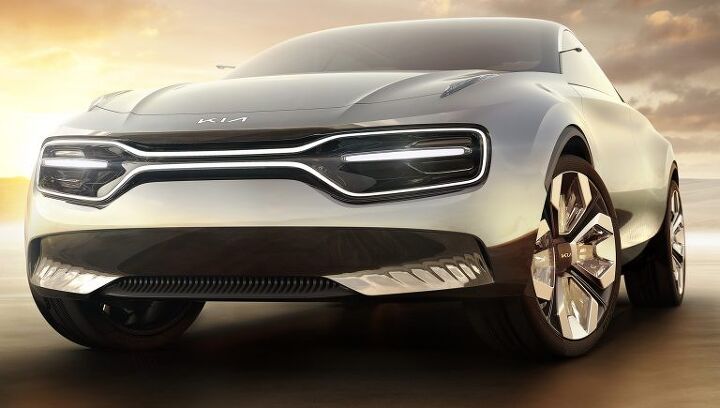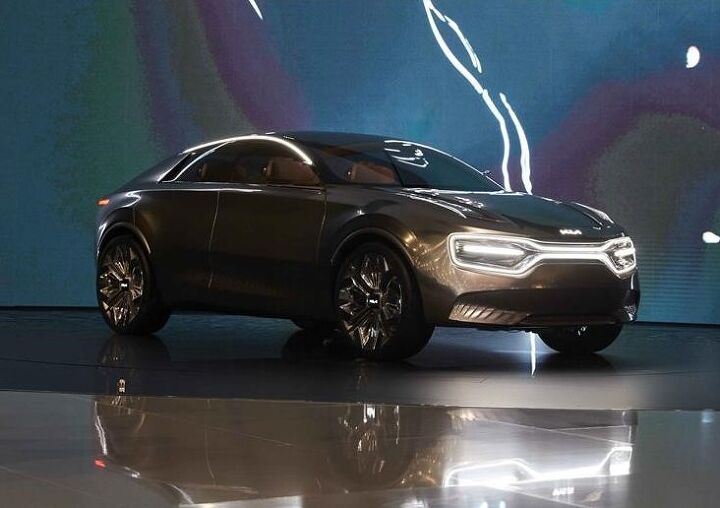Kia Imagine Bound for Production As EU Leaves Automaker 'No Choice'

A fairly stylish electric concept car revealed this past year by Kia will become a reality in 2021, the automaker’s European chief operating officer claims. The Kia Imagine, a high-riding, fastback C-segment offering, will be put into production on a dedicated platform not only because the company feels it’s a potentially successful vehicle, but because it has little choice in the matter.
Come 2020, the European Union plan to level punitive fines on any automaker caught breaking its increasingly stringent fleetwide emissions standards. It’s a case of go electric, or pay up.
Indeed, Kia Europe Chief Operating Officer Emilio Herrera comes across sounding a little like late Fiat Chrysler CEO Sergio Marchionne in his interview with Automotive News Europe, bemoaning the expected markup (and potential unprofitability) of small electric compliance cars, like those planned by Renault.
The French automaker plans to offer a 10,000 euro ($11,000) EV within a handful of years; Herrera claims a gas-free version of its Picanto city car — a vehicle under consideration by Kia brass — would nearly double the subcompact’s price. At the same time, he doesn’t see the government incentives offered by European nations lasting over the long term. Lose the subsidy, and you’re left with a car that either doesn’t sell, or can’t generate a profit.
As such, Kia is keeping its main focus on larger, less vulnerable EVs. It already has the Soul and Niro electrics, and come 2021, it will offer the far less boxy Imagine — or whatever name it ends up applying to this vehicle.
“One of our biggest challenges is to make EVs profitable, and the smaller the car, the more complicated that is. Therefore, a 10,000-euro EV is very challenging and not very realistic,” Herrera said.
“Why do we believe that the EV market will grow? The main reason is that we have no other choice. Why is Volkswagen suddenly heading in this direction now? Not because they like it but because they are forced. Volkswagen Group sells 4 million cars in Europe; they need to offset that with EVs to avoid paying the EU’s CO2 fines.”
Because of the huge take rate for mini cars in various European countries, Kia is being forced into building EV variants for the A- and B-segments, Herrera said. “Our goal is to have an electric car in almost every main segment where we compete. Even if it’s not confirmed today, I think we have no choice [but to build an electric Picanto].”
As for the coupe-like Imagine, all Herrera would say is, “The plan is for this to become a mass-produced vehicle in one or two years and to have a dedicated electric platform.”
More hybrids, both mild, conventional, and plug-in, will proliferate throughout the Kia stable, he added. When the Imagine appears, expect it to lose the suicide doors typical of splashy concept vehicles, as well as the 21 dashboard screens Kia installed to poke fun at other automakers. As for power and range, that’s TBD. Autocar has reported that Kia engineers would like to attain a driving radius of 500 miles on the European WLTP cycle.
American availability remains a question mark.
[Images: Kia Motors]

More by Steph Willems
Latest Car Reviews
Read moreLatest Product Reviews
Read moreRecent Comments
- ToolGuy First picture: I realize that opinions vary on the height of modern trucks, but that entry door on the building is 80 inches tall and hits just below the headlights. Does anyone really believe this is reasonable?Second picture: I do not believe that is a good parking spot to be able to access the bed storage. More specifically, how do you plan to unload topsoil with the truck parked like that? Maybe you kids are taller than me.
- ToolGuy The other day I attempted to check the engine oil in one of my old embarrassing vehicles and I guess the red shop towel I used wasn't genuine Snap-on (lots of counterfeits floating around) plus my driveway isn't completely level and long story short, the engine seized 3 minutes later.No more used cars for me, and nothing but dealer service from here on in (the journalists were right).
- Doughboy Wow, Merc knocks it out of the park with their naming convention… again. /s
- Doughboy I’ve seen car bras before, but never car beards. ZZ Top would be proud.
- Bkojote Allright, actual person who knows trucks here, the article gets it a bit wrong.First off, the Maverick is not at all comparable to a Tacoma just because they're both Hybrids. Or lemme be blunt, the butch-est non-hybrid Maverick Tremor is suitable for 2/10 difficulty trails, a Trailhunter is for about 5/10 or maybe 6/10, just about the upper end of any stock vehicle you're buying from the factory. Aside from a Sasquatch Bronco or Rubicon Jeep Wrangler you're looking at something you're towing back if you want more capability (or perhaps something you /wish/ you were towing back.)Now, where the real world difference should play out is on the trail, where a lot of low speed crawling usually saps efficiency, especially when loaded to the gills. Real world MPG from a 4Runner is about 12-13mpg, So if this loaded-with-overlander-catalog Trailhunter is still pulling in the 20's - or even 18-19, that's a massive improvement.




































Comments
Join the conversation
Maybe we will end up at having 3 standardised Euro Platforms "Eu01", "Eu02" & "Eu03" built by the PSA/FCA conglomerate, then shipped off to coachbuilders for the body to be done. Back to the good old days, buy a chassis and have your favourite coachbuilder build the body of your dreams. Arise, Vanden Plas, Bugatti, Vauxhall, Rolls Royce, Daimler. Resurrect your coachbuilder of choice for the colonies. Everybody will be driving 100, 200, 400-mile range vehicles.
This mad rush to electric cars fascinates me. I certainly have no problem with electric cars but I do think it premature (leaving the politics of doing so aside) to so bluntly force them on an entire continent as the EU is doing. I understand how they got to this decision though: the VW Diesel fiasco forced their hand. They had to react, and there were only two options (in their way of thinking) - gasoline instead of diesel or electric. Well, gasoline would be viewed as a step back and require a retooling of the infrastructure, and that left electric. Electric also has political appeal as it is less polluting, and popular with many people, and has geopolitical appeal as it allows the EU to lessen their dependence on Russian and Middle-Eastern oil. The infrastructure is mostly already in place in the form of electric transmission lines; only “filling stations” are necessary and for electric cars that’s no harder than installing a telephone box by the side of the road. I do think that there are some problems: electric cars are still more expensive than an ICE for a vehicle of equivalent capability, and the costs do not scale down linearly. This amounts to a regressive tax on the poor. On the geopolitical front the EU is trading their dependence on Russia and the Middle East for dependence on China for rare earths for batteries. I have no data (does anyone?) on how much additional electricity will be required for wide-spread adoption but there obviously will be, and the argument “they only charge at night” is rather offset by the fact that solar panels sleep at night. So, back to where I started - the next five years are going to be fascinating.